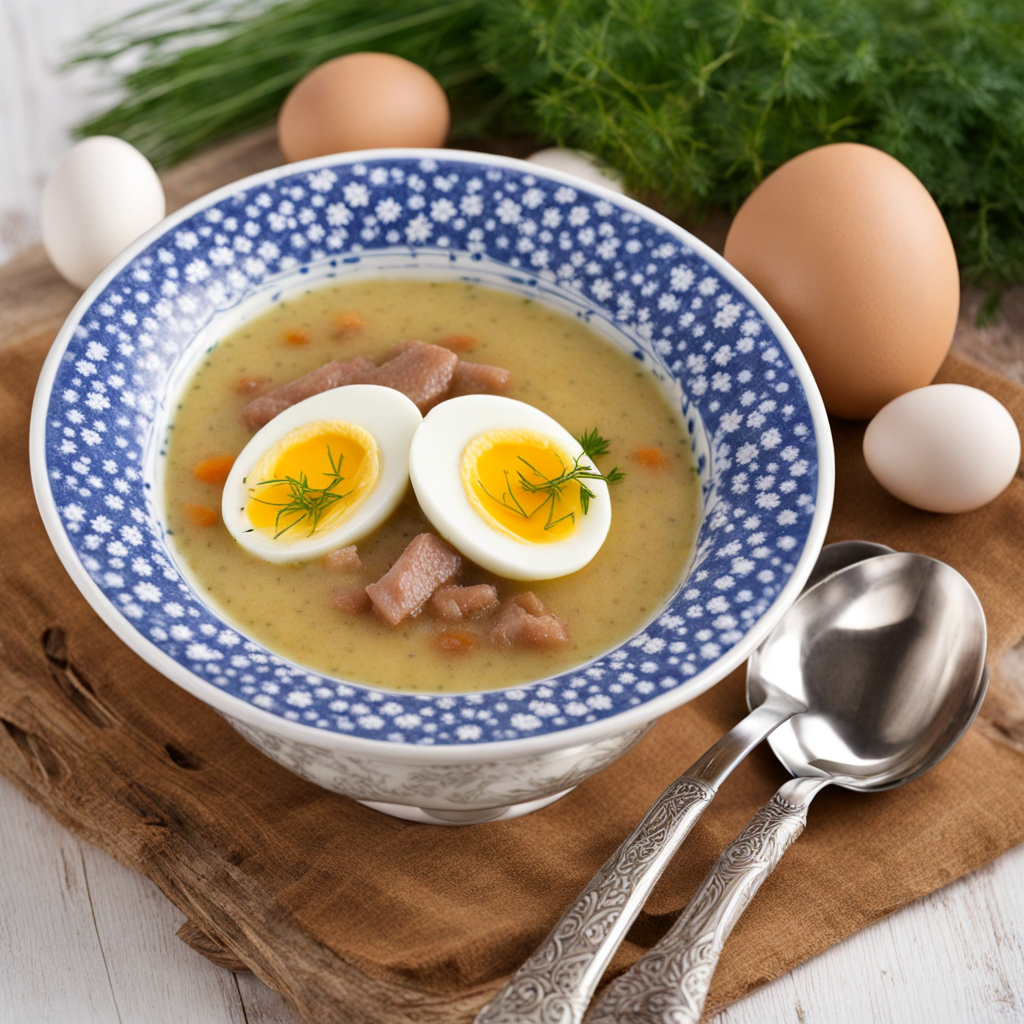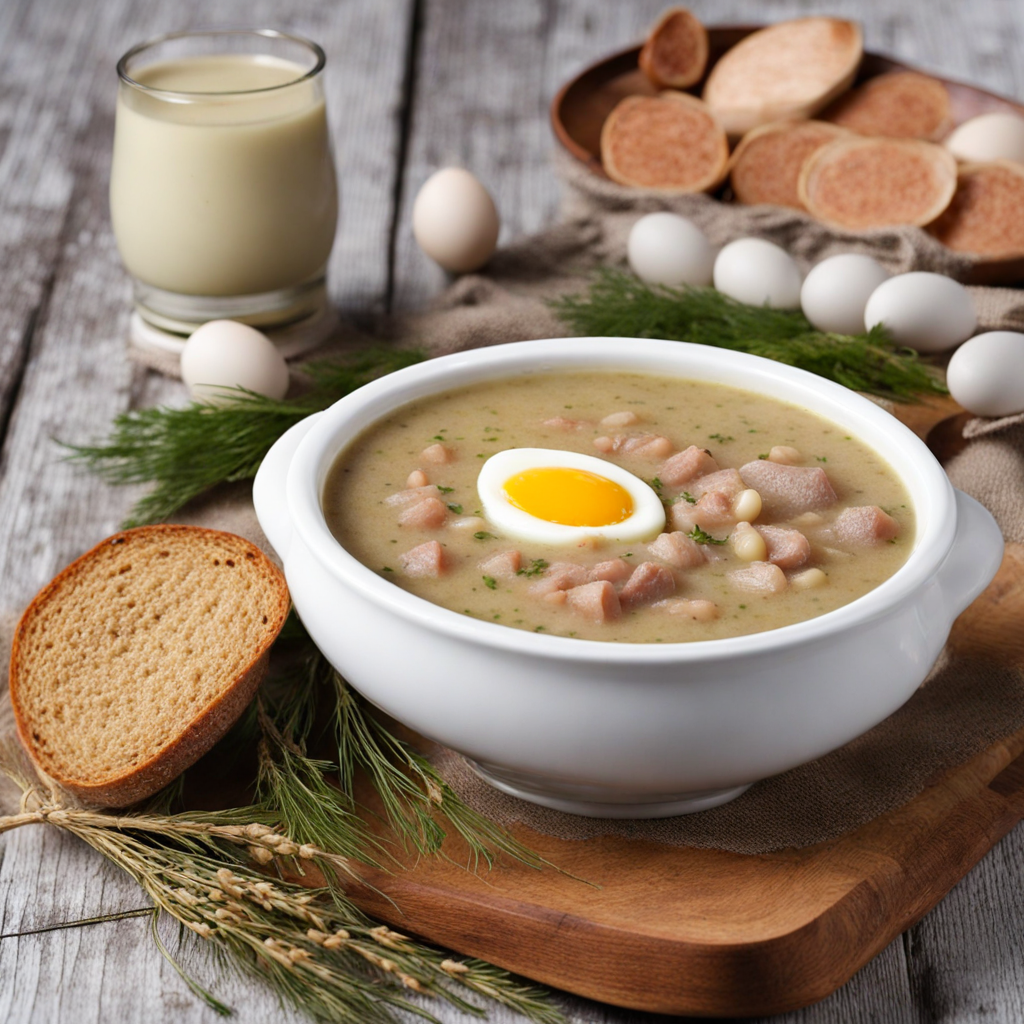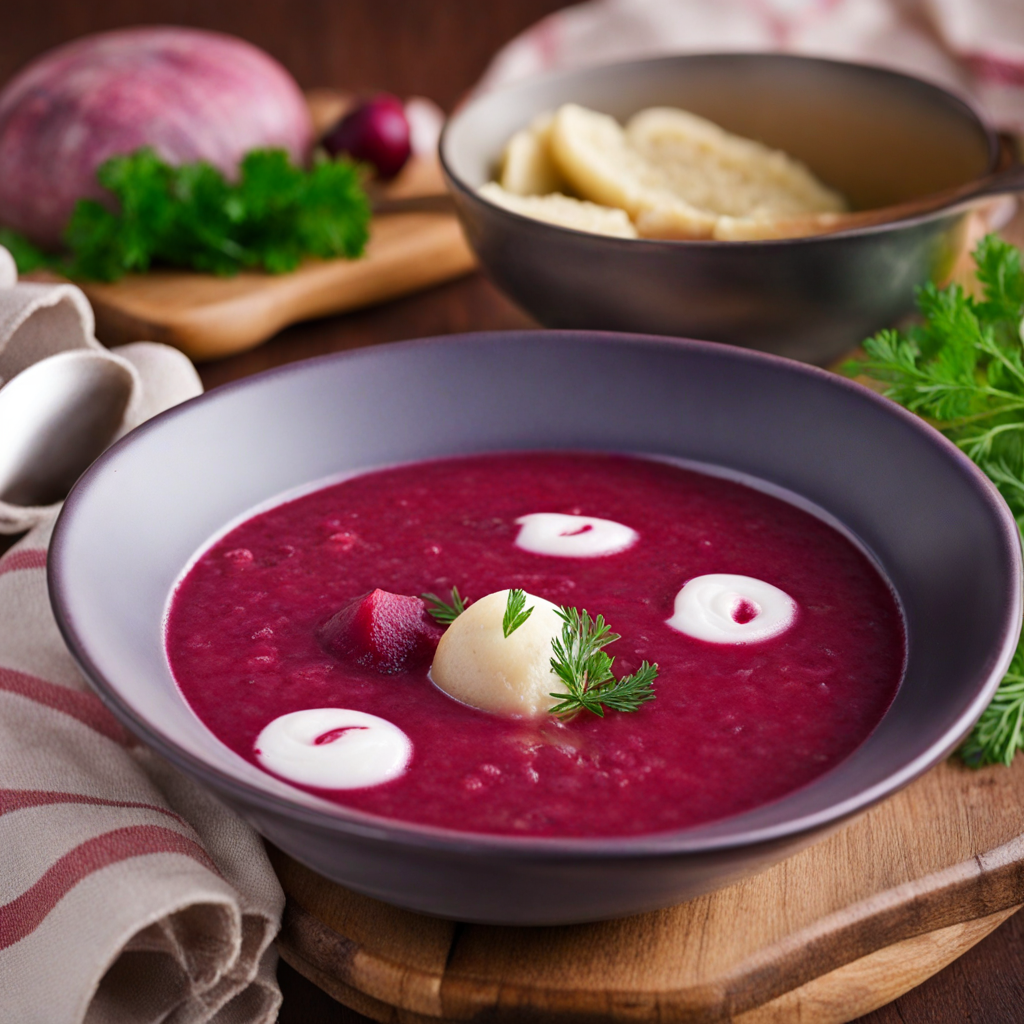Ryemeal Soup
Ryemeal Soup, or "Zupa Żytni," is a hearty and rustic Polish dish that showcases the rich flavors of rye, a staple grain in Polish cuisine. This unique soup is typically made by simmering rye flour or whole grains in a savory broth, often enhanced with ingredients like potatoes, carrots, and onions. The earthy and slightly nutty taste of the rye is complemented by the sweetness of the vegetables, creating a balanced and comforting meal that warms the soul. The texture of the soup can range from creamy to chunky, depending on how it is prepared, making each bowl a delightful experience for the palate. In addition to its wholesome base, Ryemeal Soup often features a variety of seasonal ingredients, such as mushrooms, leafy greens, or smoked meats, which add depth and complexity to the flavor profile. The use of herbs like dill or parsley further elevates the dish, providing a fresh and aromatic finish. Many families have their own treasured recipes that have been passed down through generations, adding a personal touch to this traditional Polish dish. Served hot, Ryemeal Soup is typically accompanied by a slice of crusty bread, perfect for dipping and soaking up the delicious broth. It is not only a satisfying meal but also a reflection of Poland’s agricultural heritage, showcasing the versatility and richness of rye. Whether enjoyed on a chilly day or as a comforting option during family gatherings, this soup invites anyone looking to explore the depths of Polish cuisine to savor its unique and fulfilling taste.
How It Became This Dish
The History of Żur: A Culinary Tradition of Poland #### Origins Żur, a traditional Polish soup, holds a special place in the culinary landscape of Poland. Its roots can be traced back to the medieval period, with its origins steeped in the agricultural practices and dietary needs of rural communities. The soup is primarily made from fermented rye flour, which gives it a distinctive sour taste, a characteristic that sets it apart from other soups. This fermentation process, known as "zakwas," has its historical beginnings in the need for preservation. In a time when refrigeration was non-existent, fermentation served as a method to prolong the shelf life of food. Historical references to Żur can be found as early as the 14th century, with mentions in various texts that indicate its importance in the Polish diet. The soup was particularly favored by the peasantry, as it was both economical and nourishing, made from readily available ingredients like rye, water, and the occasional addition of vegetables or meat. #### Cultural Significance Żur is not just a dish; it is a symbol of Polish culture and identity. It is often associated with Polish Easter traditions, where it is served on Easter Sunday, sometimes accompanied by a hard-boiled egg, sausage, and horseradish. This festive context elevates Żur from a simple meal to a celebratory dish, emblematic of renewal and the coming of spring. The tradition of eating Żur during Easter highlights its role as a comfort food, bringing families together to share in the joy of the holiday. Furthermore, Żur is a representation of the Polish agrarian lifestyle, showcasing the significance of rye in Polish agriculture. Rye was a hardy grain that could withstand harsh climates, making it a staple in many regions. The ability to create a nutritious meal from this grain illustrates the resourcefulness of Polish cooks throughout history. #### Development Over Time Over the centuries, Żur has evolved, influenced by various factors, including regional variations, historical events, and culinary exchanges with neighboring cultures. In its earliest forms, Żur was made quite simply with just rye and water. As trade routes opened and interactions with other cultures increased, ingredients began to diversify. In Silesia, for instance, Żur is often enriched with sausage and various meats, reflecting local tastes and the influence of German cuisine. In Kraków, you might find a version that includes potatoes, showcasing the region’s agricultural bounty. The addition of ingredients such as mushrooms, cream, or even smoked meats has contributed to a variety of recipes across Poland, each with its own unique flair. The 19th and early 20th centuries marked a significant period of change for Polish cuisine, including Żur. As Poland underwent political changes, the culinary landscape began to reflect a more unified national identity. Cookbooks and culinary literature from this period began to standardize recipes, allowing Żur to be recognized not just as a regional dish but as a national symbol. The publication of "The Polish Cookbook" in the mid-20th century helped to further solidify the place of Żur within the national culinary canon. #### Modern Interpretations In contemporary Poland, Żur continues to be a beloved dish, enjoyed year-round and not just during holidays. Its preparation has seen modern twists, with chefs experimenting with ingredients and presentation. Today, one might find Żur served in a bread bowl, a nod to modern dining aesthetics while maintaining the rustic roots of the dish. The rise of the farm-to-table movement has also reinvigorated interest in traditional foods like Żur. Many restaurants and home cooks are returning to the basics, emphasizing the use of locally sourced, organic ingredients. This resurgence reflects a growing appreciation for Polish culinary heritage and a desire to preserve traditional dishes in an ever-globalized world. #### Global Influence As Polish communities have migrated around the world, so too has Żur. In the United States, Canada, and the United Kingdom, Polish immigrants have brought their culinary traditions with them, leading to the establishment of Polish restaurants that serve Żur alongside other beloved dishes like pierogi and bigos. These establishments not only cater to the Polish diaspora but also introduce non-Polish diners to the rich flavors and cultural significance of this traditional soup. The globalization of food culture has also led to a blending of culinary practices. Chefs in various parts of the world are beginning to experiment with Żur, incorporating local ingredients and techniques. This fusion has created new interpretations of the dish, allowing it to evolve while still honoring its historical roots. #### Conclusion Żur is more than just a soup; it is a reflection of Polish history, culture, and the resilience of its people. From its humble beginnings in medieval kitchens to its status as a cherished national dish, Żur embodies the essence of Polish culinary tradition. Its evolution over time showcases the adaptability of food, influenced by agricultural practices, cultural exchanges, and the ever-changing tastes of society. As we look to the future, Żur stands as a testament to the importance of preserving culinary heritage while embracing innovation. Whether enjoyed in a rustic farmhouse or a modern restaurant, Żur continues to bring people together, reminding us of the comfort and connection that food can provide. In every bowl of this sour rye soup, there lies a story of tradition, community, and the enduring spirit of Polish culture.
You may like
Discover local flavors from Poland







